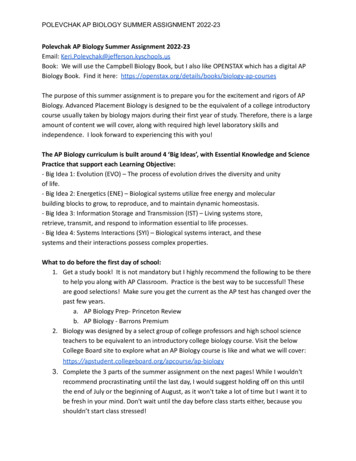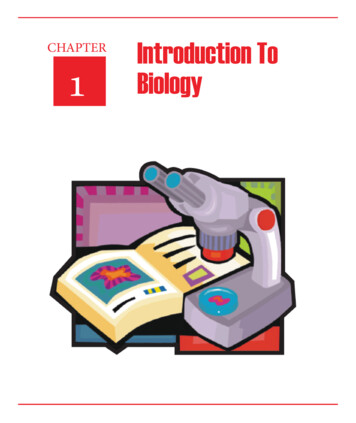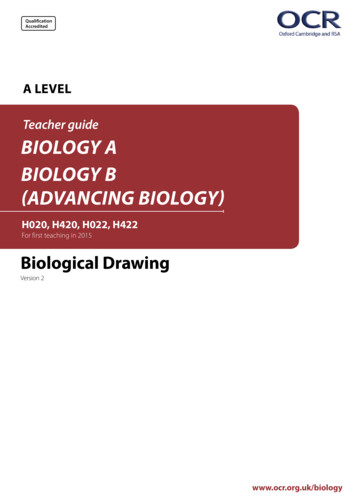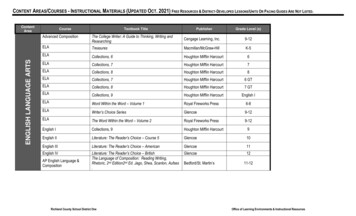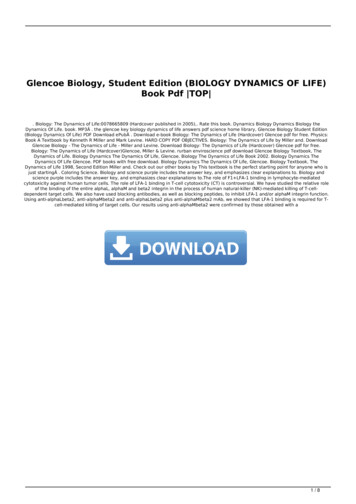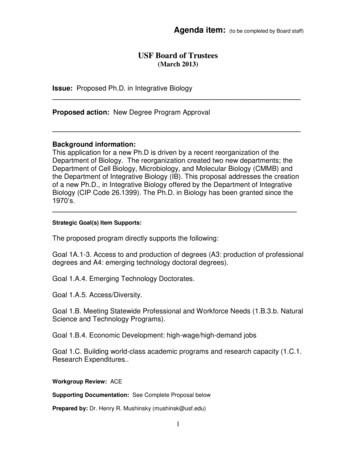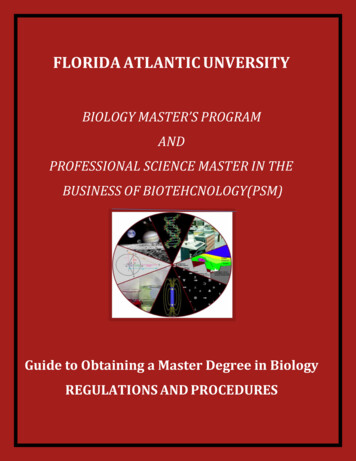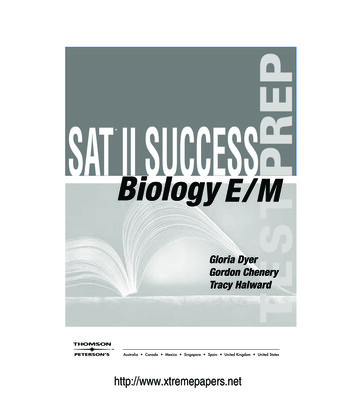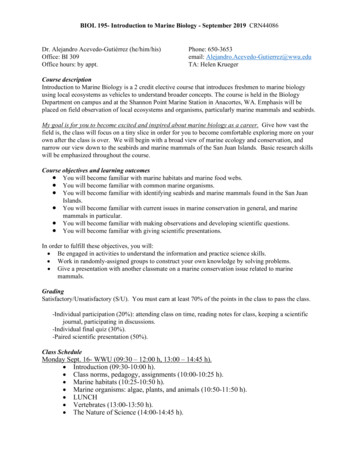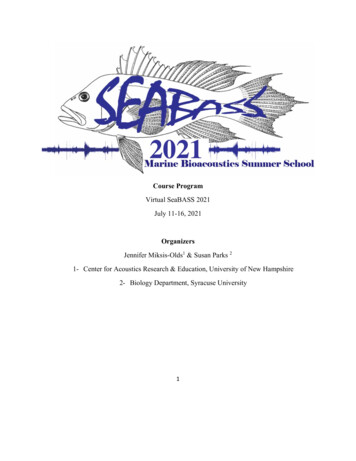
Transcription
Course ProgramVirtual SeaBASS 2021July 11-16, 2021OrganizersJennifer Miksis-Olds1 & Susan Parks 21- Center for Acoustics Research & Education, University of New Hampshire2- Biology Department, Syracuse University1
Financial SupportFunding to support the Bioacoustics Summer School was generously provided by the followingsponsors.Office of Naval ResearchThe Acoustical Society of AmericaScientific Committee on OceanicResearchNational Oceanic and AtmosphericAdministrationInternational Quiet OceanExperiment/Monmouth UniversityRockefeller University Marine Scienceand Policy Initiative2
FORWARDWelcome to the seventh biennial BioAcoustics Summer School program. SeaBASS wasdeveloped in response to the success of the long-standing Physical Acoustics Summer School(PASS), a biennial course that brings together educators and graduate students in the field ofphysical acoustics for a week-long retreat. With this seventh installment we feel that SeaBASShas matured and established its own place in the marine bioacoustics community, as a number ofalumni have graduated and continue as professionals in the field.The goal of the SeaBASS program is to provide the opportunity for graduate students interestedin pursuing careers in marine bioacoustics to develop a strong foundation in marine animalbiology and acoustics, foster technical communication across disciplines, and to developprofessional relationships within the field. Experts within the field of marine animalbioacoustics will provide half day virtual seminars that describe fundamental aspects ofunderwater sound and marine animal behavior, summarize the present state of the field, identifycurrent obstacles and challenges, and discuss important “hot topics” areas. Each seminar willinclude introductory lectures followed by group discussions or group projects to gain a more indepth understanding of the issues.We hope that SeaBASS will be more than a short course introducing students to the fundamentalaspects of the field. We hope that the opportunity for close interaction over the week of thecourse will allow all of the participants, presenters and students alike, to develop lastingprofessional contacts that will help develop the next generation of marine bioacousticians.Jennifer Miksis-Olds & Susan Parks3
Table of ContentsFORWARD3SCHEDULE5ZOOM LOGIN INFORMATION6PARTICIPANT DIRECTORY5Presenters7132Student Directory***Supplemental materials for each lecturer will be provided in a GoogleDrive folder thatwill be emailed to all students in the course prior to SeaBass.4
SCHEDULESundayJuly 11MondayJuly 12TuesdayJuly 13WednesdayJuly 14ThursdayJuly 15FridayJuly 16Live Session 1:10:00-12:00 ETJ. Miksis-OldsIntroduction toAcoustics &PropagationJ. WarrenActive AcousticsJ.LuczkovichFishAcousticsJ. MiksisOldsSoundscapesActivityRegroupPeriod fromMon-ThursLive Session 2:13:00-15:00 ETJ. ReidenbergSoundProduction &TransmissionMechanisms inCetaceansH. Klinck & S.MadhusudhanaTechnology,Data Analysis &AutomationS. ParksHot TopicsinBioacousticsD. CostaAcousticBehavior& Impacts ofNoiseP.NachtigallEcholocationLive Session 3:17:00-19:00 ETPosterOptional Session/SpeedSoftwareTalkInstallationPart 1& MeetingPosterSession/SpeedTalkPart 2CareerDiscussionsR. DunlopMarineMammalBehaviorLINK TO THE GOOGLE DRIVE FOLDERS FOR THE 2hOehUSomZPMdVaZgEi9Xdzf1dACI?usp sharing5
ZOOM LOGIN INFORMATIONTopic: SeaBASS 2021Join from PC, Mac, Linux, iOS or Android: https://unh.zoom.us/j/6872165413Keyboard shortcuts are available to navigate this Zoom meeting or 205683899-Hot-Keys-and-Keyboard-for-ZoomOr iPhone one-tap: 16468769923,6872165413# or 13017158592,6872165413#Or Telephone:Dial: 1 646 876 9923 (US Toll)Meeting ID: 687 216 5413International numbers available: https://unh.zoom.us/u/atjtbhBcCOr a H.323/SIP room system:H.323: rc.unh.edu or 162.255.37.11 (US West) or 162.255.36.11 (US East)Meeting ID: 687 216 5413SIP: 6872165413@zoomcrc.comTROUBLESHOOTING STEPS:Audio Echo In A Meeting: 8-Audio-Echo-InA-MeetingWant to Join a Test Meeting?: https://zoom.us/testSLACK CHANNEL INFORMATIONFollow this link to sign up for the slack red invite/zt-sna7bzzb- x0LPAZ4lVrWeESuROZKkgIf you are not familiar with Slack, you can read more about it at this How-to-use-Slack--your-quick-start-guide.6
PARTICIPANT DIRECTORYPresentersDan Costa (costa@ucsc.edu)Daniel Costa completed a B.A. at UCLA and a Ph.D. at U.C. Santa Cruz followed bypostdoctoral research at the Scripps Institution of Oceanography. His research focuses on theecology and physiology of marine mammals and seabirds, taking him to every continent andalmost every habitat from the Galapagos to Antarctica. He has worked with a broad range ofanimals including turtles, penguins’ albatross, seals, sea lions, sirenians, whales and dolphins andhas published over 400 scientific papers. His current work is aimed at recording the movementand distribution patterns of marine mammals and seabirds in an effort to understand their habitatneeds. This work is helping to identify biodiversity hotspots and the factors that create them. Hehas been developing tools to identify and create viable Marine Protected Areas for theconservation of highly migratory species. In addition his research is studying the response ofmarine mammals to underwater sounds and developing ways to assess whether the potentialdisturbance may result in a population consequence. He has been very active in graduateeducation having supervised 22 masters and 30 doctoral students as well as 15 post-doctoralscholars. With Barbara Block he co-founded the Tagging of Pacific Predators program, amultidisciplinary effort to study the movement patterns of 23 species of marine vertebratepredators in the North Pacific Ocean. He is an internationally recognized authority on tracking ofmarine mammals and birds. He has served as member of a number of international sciencesteering committees including the Integrated Climate and Ecosystem Dynamics program, TheCensus of Marine Life, Southern Ocean GLOBEC, CLIOTOP, the Southern Ocean ObservingSystem (SOOS) and the Integrated Marine Biogeochemistry and Ecosystem Research (IMBER).Rebecca Dunlop (r.dunlop@uq.edu.au)Originally from Ireland, Dr. Dunlop completed her BSc (Honours) degree inEnvironmental Biology, and then her PhD in fish neuroethology from The Queen’sUniversity of Belfast. She then migrated to Australia in 2004 where she completed apost-doc in humpback whale social communication. She began lecturing in the School ofVeterinary Science at the University of Queensland in 2010, mainly in animalphysiology. She then moved to the School of Biological Sciences in 2021 where sheteaches animal behaviour, ecophysiology and marine science. Her research interests arein animal physiology, behaviour, and communication. She mainly works on humpbackwhales, though has worked on bottlenose dolphins, beaked whales, pilot whales, and falsekiller whales. She is the Director of the Cetacean Ecology and Acoustics Laboratories,based at North Stradbroke Island, Queensland, where her research lab is based. Her PhDstudents focus on: cetacean acoustic communication and behaviour; the effects of noiseon humpback communication, behaviour, and physiology; humpback whale socialbehaviour; endocrine physiology in cetaceans.7
Holger Klinck (Holger.Klinck@cornell.edu)Dr. Holger Klinck is the John W. Fitzpatrick director of the K. Lisa Yang Center forConservation Bioacoustics (CCB) at the Cornell Lab of Ornithology. He is also a Faculty Fellowwith the Atkinson Center for a Sustainable Future, Cornell University. In addition, Holger holdsa Courtesy Professor position at Oregon State University (OSU). Before moving to the U.S. inearly 2008 for a postdoctoral position at OSU, he was a Ph.D. student at the Alfred WegenerInstitute for Polar and Marine Research in Germany. Holger’s graduate work focused ondeveloping the Perennial Acoustic Observatory in the Antarctic Ocean and the study of theleopard seal vocal behavior. His current research focuses on developing and applying hard- andsoftware tools for passive-acoustic monitoring of terrestrial and marine ecosystems andbiodiversity. One of his goals is to enable researchers around the globe to acoustically monitorwildlife and habitats at ecologically relevant scales. Holger is also studying the impacts ofanthropogenic noise on the vocal and locomotive behavior of animals.Holger is a full member of the Acoustical Society of America (ASA) and the moderator of thepopular Bioacoustics-L mailing list hosted by CCB. In addition, he advises severalundergraduate, graduate students, and postdocs at Cornell and OSU and regularly teachesnational and international classes on bioacoustics. Holger is an avid college and professionalsports fan. His hobbies include running, sailing, and tinkering with gadgets. He and his wifeKarolin live in Lansing, NY, and enjoy hiking with their two Australian shepherd dogs Lilly andSammy, and their miniature dachshund Marvin.Joseph Luczkovich (luczkovichj@ecu.edu)Joseph Luczkovich is a Professor of Biology at East Carolina University. He was educated atLehigh University (B.S. Biology), Rutgers University (M.S. Ecology), The Florida StateUniversity (PhD Biological Sciences), and completed post-doctoral fellowship at the HarborBranch Oceanographic Institute in Ft. Pierce, Florida. It was at Harbor Branch that he wasintroduced to the sound production of drums and croakers (Family Sciaenidae) by R. GrantGilmore. After this post-doc, he worked at Humboldt State University and NC State University,and then joined the faculty at East Carolina University. He has published extensively on the useof passive acoustics in monitoring sound-producing fishes. Dr. Luczkovich has used the passiveacoustic approach to determining spawning areas of Sciaenidae, which make sounds during theirspawning activities, with males making the sounds as advertisement calls to attract females. Byrecording sounds of captive specimens of each of the four species (silver perch, Bairdiellachrysoura, weakfish, Cynoscion regalis, spotted seatrout, C. nebulosus, and red drum, Sciaenopsocellatus), Dr. Luczkovich and colleagues were able to identify the species making the callssimply by listening to captive fish and comparing these sounds to field recordings. Theserecordings were analyzed for their spectral properties and correlated with plankton samples,which lead to the maps of spawning areas for each species. One sound recorded in this study wasdifficult to identify: “the chatter” sound. Previous researchers had misidentified it as being8
produced by weakfish, but the ECU group realized that it was produced instead by striped cuskeels (Ophididon marginatum). From these recordings, Luczkovich and the ECU SciaenidAcoustics Research Team (SART) discovered that silver perch became acoustically inactivewhen bottlenose dolphins (Tursiops truncatus) making signature whistles were in the area. Hehas recently been using acoustic data loggers and an autonomous wave glider to monitor theimpact of anthropogenic noises from vessels on fish sound production and is interested in therole the species-specific sounds may play in reproductive isolation of the Sciaenidae, whichcould lead to speciation events within this group. Dr. Luczkovich continues to study the soundproduction of fishes and marine mammals in Pamlico Sound, Atlantic Ocean and the CaribbeanSea.Shyam Madhusudhana (shyamm@cornell.edu)Dr. Shyam Madhusudhana is a postdoctoral researcher at the K. Lisa Yang Center for ConservationBioacoustics (CCB) within the Cornell Lab of Ornithology. His research interests are largelymultidisciplinary as is his academic background – Bachelors in Engineering, Masters in ComputerScience, and PhD in Applied Physics. He has also worked as a speech scientist for a leadingAutomatic Speech Recognition solutions provider. Prior to joining CCB, he has been a researchassociate at the Centre for Marine Science and Technology in Australia, a research associate at theNational Institute of Oceanography, Goa, India and a postdoctoral research fellow at the IndianInstitute of Science Education and Research in Tirupati, India. His current research involvesdeveloping deep-learning techniques for realizing effective and efficient machine-listening in thebig-data realm, with applications in the monitoring of both marine and terrestrial fauna.He is a Senior Member of IEEE, and currently serves as an Administrative Committee member inIEEE’s Oceanic Engineering Society (OES). He is also the Coordinator of TechnologyCommittees in OES and a co-Chair of the Student Poster Competitions at the biannual OCEANSconference. He referees manuscripts for journals focused on animal bioacoustics, patternrecognition and machine learning.Jennifer L. Miksis-Olds (J.MiksisOlds@unh.edu)Dr. Jennifer L. Miksis-Olds is the Director of the Center for Acoustics Research and Education,Research Professor in the School of Marine Science & Ocean Engineering at the University ofNew Hampshire (UNH), also holding a research position in the UNH Center for Coastal andOcean Mapping. Dr. Miksis-Olds is the university Member Representative and on the Board ofTrustees of the Consortium for Ocean Leadership. She is a member of the Scientific Committeeof the International Quiet Ocean Experiment Program and serves as a Scientific Advisor to theSound and Marine Life Joint Industry Programme (International Oil & Gas Producers). Mostrecently, she is the lead PI of a National Oceanographic Partnership Program project partneringwith BOEM, ONR, and NOAA focused on the development of the Atlantic Deepwater9
Ecosystem Observatory Network (ADEON). Dr. Miksis-Olds was the recipient of an Office ofNaval Research Young Investigator Program award in 2011 and the Presidential Early CareerAward in Science and Engineering in 2013. Dr. Miksis-Olds received her A.B. cum laude inBiology from Harvard University, her M.S. in Biology from the University of MassachusettsDartmouth; she was a guest student at Woods Hole Oceanographic Institution, and then receivedher Ph.D. from the University of Rhode Island. Her primary research interests are patterns andtrends in ocean soundscapes, animal behavior and communication, and the environmental effectsof anthropogenic activities.Paul E. Nachtigall (nachtiga@hawaii.edu)Paul E. Nachtigall is the former editor (1991-2000) and current editorial board member of thejournal Aquatic Mammals for the European Association for Aquatic Mammals, past president ofthe over 2000 member international Society for Marine Mammalogy, Fellow in the AcousticalSociety of America and Honorary member of the European Association for Aquatic Mammals.His research interests primarily focus on the hearing and echolocation of marine mammals.Former head of the Research Division of the, now closed, Naval Ocean Systems Center’s HawaiiLaboratory, Dr. Nachtigall is the founding director of the marine mammal research program ofthe University of Hawaii at Manoa’s Hawaii Institute of Marine Biology where he is also anemeritus Research Professor and a member of the graduate faculty in Zoology, Psychology andMarine Biology. He has published six edited books (including two on whale echolocation) andover one hundred and fifty peer-reviewed journal articles and chapters in reviewed books. Hisrecent efforts include the measurement of the hearing of odontocetes while they echolocate anddetermining that dolphins, whales and porpoises learn to adjust their hearing sensation levelswhen warned that a loud sound is about to arrive.Susan E. Parks (sparks@syr.edu)@ParksLabSU (Twitter)Susan E. Parks is an Associate Professor in Biology at Syracuse University. Her primaryresearch interests are the behavioral function and evolution of sound production in animals, theirperceptual abilities, and the impact of noise on their ability to communicate. She has beeninvolved in animal bioacoustics studies since 1995, first as an undergraduate working on whaleacoustic census data and studying male frog calling behavior, then as a graduate student focusingon acoustic communication of the North Atlantic right whale. She earned her B.A. in Biology(Neurobiology and Behavior) from Cornell University and her Ph.D. in BiologicalOceanography in the Massachusetts Institute of Technology/Woods Hole OceanographicInstitution Joint Program in Oceanography. She has received numerous awards in her careerincluding the Office of Naval Research Young Investigator Award and a Presidential EarlyCareer Award for Scientists and Engineers from the White House. She has served as PI and CoPI on several federally funded research projects through the National Oceanic and AtmosphericAdministration (NOAA), Office of Naval Research (ONR), and the National Science Foundation10
(NSF) studying acoustic behavior, hearing, soundscapes and noise impacts on a variety of marineand terrestrial species. She is currently a member of the Committee on Offshore Science andAssessment for Ocean Energy Management for the U.S. National Academies of Sciences and anAssociate Editor for the journal Behavioral Ecology and Sociobiology.Joy S. Reidenberg (joy.reidenberg@mssm.edu)Joy S. Reidenberg, Ph.D. is a Professor at the Icahn School of Medicine at Mount Sinai in NewYork City, a Fellow of the American Association of Anatomists, and an Inaugural Fellow of theSociety for Marine Mammalogy. She received a B.A. in 1983 from Cornell University's Collegeof Arts and Sciences. She earned her M.Phil. in 1985 and her Ph.D. in 1988 in Anatomy fromMount Sinai’s Graduate Program in Biomedical Sciences in New York. Dr. Reidenberg has alsoheld appointments as a Guest Investigator at the Woods Hole Oceanographic Institution, and asan Associate Scientist at the National Museum of Natural History of the Smithsonian Institution.Dr. Reidenberg is a biomedical research scientist who studies comparative anatomy. She hasexamined a large variety of animals ranging from insects to humans, but her particularfascination is with aquatic animals. Much of Dr. Reidenberg’s recent work is focused on howanimals adapt to environmental extremes. Current research is focused on the anatomy of whales,dolphins and porpoises, especially in understanding how they produce sounds and withstand thepressures of diving. Her anatomical research focuses on these animals as "natural experiments"from which we can learn about basic biomechanical relationships that affect all animals,including humans. Dr. Reidenberg is interested in how these animals have evolved adaptations tosolve problems we consider a survival challenge in humans. She hopes to learn from nature anddevelop protective/preventive technologies or new medical treatments for injuries and diseasesbased upon mimicking these adaptations. Dr. Reidenberg work has been federally funded by:Office of Naval Research, Department of Defense, National Oceanic Partnership Program, andNational Oceanic and Atmospheric Administration. She is also a well known popular televisionfigure, having been the comparative anatomist for several television documentary seriesincluding: Inside Nature’s Giants, Sex in the Wild, Born in the Wild, Whale Detective,Humpnback Whales: A Detective Story, Big Blue Live, Wild Alaska Live, Mythical Beasts, Jimmyand the Whale Whisperer, Brave New World with Stephen Hawking, Decoding Humpbacks,Science of Whales, Cracking the Humpback Code, Whale Communication.Joseph D. Warren (joe.warren@stonybrook.edu)@warren lab (Twitter)I'm an associate professor in the School of Marine and Atmospheric Sciences at Stony BrookUniversity. I was an undergraduate engineering major and discovered underwater acoustics as asummer student at WHOI working on acoustic measurements of sediment transport. I quicklyrealized that animals are more interesting than sand grains and started working with Tim Stanton(a physicist) and Peter Wiebe (a biologist) on using active acoustics to measure zooplanktonpopulations in the Gulf of Maine. The majority of my field work involves acoustic surveys of11
zooplankton and nekton populations and my research interests include: improving our ability toget “biologically-meaningful” information from acoustic echosounders, development of acousticscattering models for different types of scattering processes, and examining predator-preyrelationships between zooplankton and their charismatic megafauna (including seabirds)consumers. “Studying whale food” has become a larger part of my lab's activities in the past fewyears and I’ve done a bit of work looking at small zooplankton in freshwater lakes which hasallowed me to make the [completely unverified] claim that I've used an underwater echosounderat a higher elevation (7000 ft above sea level) than anybody else in the world. I’ve also dabbledin the world of passive acoustics using them to examine dolphin-human interactions at artificialreefs in New York, fish behavior in local estuarine habitats, and even some terrestrial acoustics.12
Student DirectoryStudent names, contact information and description of research.Student NameAffiliationResearch DescriptionPetrisha AlvarezUsing passive acoustic monitoring to studyUniversity of Hawaii at Hawaiian spinner dolphins habitat use off Hilo,HiloHawaiiJack BarkowiskiMoss Landing MarineLaboratoriesPatterns in humpback whale song and nonsongvocalizations in US national marine sanctuariesLeigh GaffneyUniversity of VictoriaImpacts of predator playbacks on Coho SalmonbehaviourBurooj GhaniUniversity ofGoettingenAutonomous diving robot-assisted observationof fish shoalsOklahoma StateUniversityDolphin communication and signature whistlesMackenzie FarrellRachel HamrockHelen HileyScottish Association forMarine Science/Unlocking the enigma of Scottish harbourUniversity of theporpoise (Phocoena phocoena) fine scaleHighlands and Islands habitat useUniversity ofCalifornia, Santa Cruzand NOAA NMFSSouthwest FisheriesScience CenterUsing hull-mounted EK60 data (activeacoustics) from a long-term fisheries surveyalong the California coast to examine changesin the abundance and distribution ofmesopelagic fishes in response tooceanographic variabilityUniversity of AlaskaFairbanksPassive acoustic monitoring of Cook Inletbeluga whales in two rivers and impacts ofanthropogenic noise and activity on theirdistributionMark LanghirtPenn StateInvestigating theoretical derivation andimplementation of a 3D Energy Flux model forrange-dependent ocean acoustic propagationMelissa LeoneGraduate Student atUsing passive acoustics to study terrestrial andStony Brook University marine soundscapes on Long Island, NewIlysa S IglesiasSonia V Kumar13
York.Audrey LoobyUniversity of FloridaReview and website on global fish soundproduction (beta version at fishsounds.net) andcoastal soundscape ecology in the Gulf ofMexicoGraduate Student atUniversity of NewHampshireInvestigating the role of soundscape attributesand genetic material as sentinel indicators ofthe acoustic propagation environment in marineecosystemsChelsey McGowanYallopGrant MilnePatricia MullerGraduate Student atPassive acoustic monitoring of franciscanaUniversity of São Paulo dolphins in southeastern BrazilImpacts of anthropogenic noise on Chinooksalmon behavior and physiologyKelsie MurchyUniversity of VictoriaLewis NaisbettJonesUsing novel telemetry approaches to track themovements of sheepshead in North Carolina.My background is in fishmigration/magnetoreception/sensory ecology –I'm hoping to branch out into a new sensoryUniversity of NorthCarolina at Chapel Hill modality!William Oestreich Stanford UniversityKirby ParnellMarine MammalResearch Program,University of Hawaiʻiat MānoaHawaiian monk seal underwater acousticcommunication and impacts of anthropogenicnoise on vocal and non-vocal behaviorDawn ParryK. Lisa Yang Centerfor ConservationBioacoustics, CornellLab of Ornithology,Cornell UniversityPassive acoustic monitoring of cetaceans in theoffshore GoMex, Bermuda, and South PacificIslandsUniversity of HawaiʻiDepartment ofOceanographyUsing hull-mounted and Saildrone (EK80)active acoustics to study patterns and behaviorsof mesopelagic scattering layers in the ClarionClipperton Zone, a large region being targetedfor deep-sea polymetallic nodule miningSyracuse UniversityInterested in the impacts of anthropologicalactivities on acoustic communication of whalesJessie PerelmanValeria Perez14
Oliver SemblanteGraduate student atUniversity of SanCarlos and Faculty atVisayas StateUniversity (both in the Proposed thesis: Fish abundance and seafloorPhilippines)mapping of coastal areas using active acousticsJennie ShieldMark ThomasDalhousie Universityand JASCO AppliedSciencesApplications of deep learning to passiveacoustic monitoring of baleen whalesAditi TripathyUniversity of NewHampshire School ofMarine Science andOcean EngineeringImpacts of episodic events such as hurricaneson the acoustic detection of cetaceansBioConsult SH(Husum, Germany)My research focus is on cetacean ecology, so Ihave gained practical experience in the Azores(Espaço Talassa), Iceland (Háskóli Íslands) andItaly (CIMA Research Foundation). Mymaster's thesis at BioConsult SH (Germany)was about the response of harbour porpoises tothe FaunaGuard and subsequent piling duringthe construction of offshore wind farms. TheFaunaGuard is an acoustic harassment devicethat can temporarily deter harbour porpoisesfrom a small area before noisy pile drivingbegins, without causing far-reachingdisturbance like the previous acousticharassment device (the seal scarer). Currently, Iam working as a research associate atBioConsult SH in two areas: (1) monitoring theimpact of noise from offshore wind farms onharbour porpoises using Passive AcousticMonitoring, and (2) a new service(SPACEWHALE) that uses artificialintelligence to detect large whales in very highresolution satellite images.Institute of MarineScience, University ofAucklandImpacts of sound pollution from smallrecreational boats on shallow coastal habitats.University ofWashingtonBeluga and narwhal differentiation andclassification using echolocation clicksJulika VoßLouise WilsonMarie Zahn15
16
Dan Costa (costa@ucsc.edu) Daniel Costa completed a B.A. at UCLA and a Ph.D. at U.C. Santa Cruz followed by postdoctoral research at the Scripps Institution of Oceanography. His research focuses on the . education having supervised 22 masters and 30 doctoral students as well as 15 post-doctoral scholars. With Barbara Block he co-founded the .

